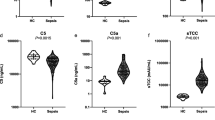Abstract
The kinetics of C-reactive protein (CRP) were studied prospectively in 30 children (aged 21 days–16 years) undergoing open heart surgery. CRP was related to the kinetics of total haemolytic complement, complement C3a and postoperative complications. Two (7%) patients died and ten (33%) had postoperative complications. The patients with complications were younger (p<0.035), underwent longer perfusions (p<0.001) and had longer aortic cross-clamping times (p<0.003). The mean peak CRP level after surgery (108 mg/l) was reached, on the average, in 43 h. No statistical difference in CRP concentrations was found between the complication and non-complication groups. Extensive complement activation was seen in every patient. CRP did not reflect the magnitude of complement activation induced by cardiopulmonary bypass. The patient sample was too small to draw reliable conclusions about the value of CRP in detecting postoperative complications after open heart surgery in children.
Similar content being viewed by others
References
Kirklin JK, Westaby S, Blackstone EH, Kirklin JW, Chenoweth DE, Pacifico AD (1983) Complement and the damaging effects of cardiopulmonary bypass. J Thorac Cardiovasc Surg 86:845–857
Pepys MB (1981) C-reactive protein fifty years on. Lancet I:653–656
Boralessa H, De Beer FC, Manchie A, Whitman JG, Pepys MB (1986) C-reactive protein in patients undergoing cardiac surgery. Anaesthesia 41:11–15
Kress HG, Gehrsitz P, Elert O (1987) Predictive value of skin testing, neutrophil migration and C-reactive protein for postoperative infections in cardiopulmonary bypass patients. Acta Anaesthesiol Scand 31:397–404
Peltola H, Vahvanen V, Aalto K (1984) Fever, C-reactive protein, and eryhtrocyte sedimentation rate in monitoring recovery from septic arthritis: a preliminary study. J Pediatr Orthop 4:170–174
Hugli TE, Chenoweth DE (1980) Biologically active peptides of complement: techniques and significance of C3a and C5a measurement. In: Nakamura RM, Dito WR, Tucker ES III (eds) Clinic laboratory techniques for the 1980's. Liss, New York, pp 443–460
Rowland M, Tozer TN (1980) Clinical pharmacokinetics: concepts and applications. Lea and Febiger, Philadelphia, pp 288–289
Fischer CL, Gill C, Forrester MG, Nakamura R (1976) Quantitation of “acute-phase” proteins postoperatively: value in detection and monitoring of complications. Am J Clin Phatol 66:840–846
Chenoweth DE, Cooper SW, Hugli TE, Stewart RW, Blackstone EH, Kirklin JW (1981) Complement activation during cardiopulmonary bypass. Evidence for generation of C3a and C5a anaphylatoxins. N Engl J Med 304:497–503
Collett B, Alhaq A, Abdullah NB et al. (1984) Pathways to complement activation during cardiopulmonary bypass. Br Med J 289:1251–1254
Meri S, Aronen M, Leijala M (1988) Complement activation during cardiopulmonary bypass in children. Complement 5:46–54
Best N, Sinosich MJ, Teisner B, Grudzinskas JG, Fischer MMcD (1984) Complement activation during cardiopulmonary bypass by heparin-protamine interaction. Br J Anaesth 56:339–343
Claus DR, Siegel J, Petras K, Osmand AP, Gewurtz H (1977) Interactions of C-reactive protein with the first component of human complement. J Immunol 119:187–192
Sabel K-G, Wadsworth C (1979) C-reactive protein (CRP) in the early diagnosis of neonatal septicemia. Acta Paediatr Scand 68:825–831
Bell DM, Goldmann DA, Hopkins CC, Karchmer AW, Moellering RC (1978) Unreliability of fever and leucocytosis in the diagnosis of infection after cardiac valve surgery. J Thorac Cardiovasc Surg 75:87–90
Craddock PR, Fehr J, Brigham KL, Kronenberg RS, Jacob H (1977) Complement and leukocyte-mediated pulmonary dysfunction in hemodialysis. N Engl J Med 296:769–774
Hammersmith DE, Weaver LJ, Hudson LD, Craddock PR, Jacob HS (1980) Association of complement activation and elevated plasma-C5a with adult respiratory distress syndrome: pathophysiological relevance and possible prognostic value. Lancet I:947–949
Author information
Authors and Affiliations
Rights and permissions
About this article
Cite this article
Aronen, M., Leijala, M. & Meri, S. Value of C-reactive protein in reflecting the magnitude of complement activation in children undergoing open heart surgery. Intensive Care Med 16, 128–132 (1990). https://doi.org/10.1007/BF02575308
Received:
Accepted:
Issue Date:
DOI: https://doi.org/10.1007/BF02575308




